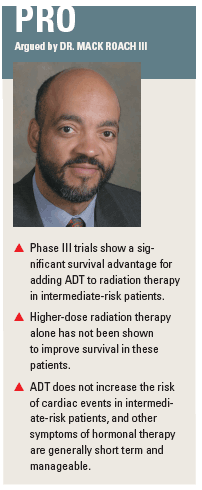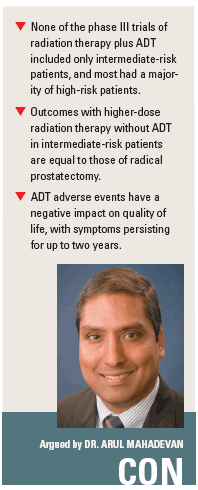Should ADT be part of care for all patients with intermediate-risk prostate cancer?
SAN FRANCISCO-Studies show improved outcomes when androgen deprivation therapy (ADT) is part of the care for men with intermediate-risk prostate cancer, said Mack Roach III, MD, taking the “pro” side of a debate on the issue. But “con” speaker Arul Mahadevan, MD, argued that the studies in question included mostly high-risk patients, and that monotherapy is effective in intermediate-risk patients.
ABSTRACT: A number of phase III studies show improved survival in intermediate-risk patients when ADT is added to radiation therapy, but some question whether the majority of the patients in these studies were really intermediate-risk.
SAN FRANCISCO-Studies show improved outcomes when androgen deprivation therapy (ADT) is part of the care for men with intermediate-risk prostate cancer, said Mack Roach III, MD, taking the “pro” side of a debate on the issue. But “con” speaker Arul Mahadevan, MD, argued that the studies in question included mostly high-risk patients, and that monotherapy is effective in intermediate-risk patients.
Dr. Roach, professor of radiation oncology and urology at the University of California, San Francisco, Helen-Diller Family Comprehensive Cancer Center, and Dr. Mahadevan, a radiation oncologist at Radiation Oncology Associates, Seacoast Cancer Center, Wentworth-Douglass Hospital in Dover, N.H., squared off at the 2008 Oncology Congress.

Both speakers agreed on the definition of intermediate-risk patients: T2b-T2c disease or Gleason score (GS) 7 or PSA of 10 to 20 ng/mL. Patients with any combination of these features may be considered high risk.
Dr. Roach cited the NCCN guidelines on prostate cancer as his first argument in favor of ADT for intermediate-risk patients. The guidelines state that patients with intermediate-risk prostate cancer may be considered for pelvic lymph node irradiation and four to six months of neoadjuvant ADT with or without adjuvant ADT.
He then cited nine randomized trials that included neoadjuvant ADT plus external beam radiation therapy (EBRT) in one or more arms. The median PSA levels in these studies (10 to 26 ng/mL), he noted, were in the range considered to be intermediate risk. “This is a lot of studies with over 5,900 patients treated on 22 arms,” Dr. Roach said. “None of them had negative results for EBRT plus ADT in terms of biochemical control, and some showed a survival advantage and improvement in distant metastases.” He acknowledged that some of these studies included both intermediate- and high-risk patients and even a few low-risk patients.
However, if a Gleason score < 8 is considered intermediate risk, the percentage of intermediate-risk patients was 50%, 70%, 80%, and 85% in four representative studies.
“So I would argue that a large percentage of these trials included patients with intermediate-risk prostate cancer,” Dr. Roach said.
Dr. Roach was critical of a recent “hypothesis-generating” analysis (D’Amico et al: J Clin Oncol 25:2420-2425, 2007) suggesting an increased risk of fatal MI with ADT based on patients from three trials. The authors concluded that those age 65 or older who received six months of ADT had shorter times to fatal MI, compared with those in the same age group who received no ADT and those younger than age 65. In the older age group, there was no difference between six to eight months of ADT vs three months.
Dr. Roach called the cutoff of age 65 arbitrary, since the median age of the patients in the study was 70. He noted that the result is based on a very small number of events, so that the difference in risk at two years was only 2.5%, which he called “statistical noise.”

Further, the ultimate risk of fatal MI (at eight years) in patients over 65 was similar between those who received six months of ADT and those who did not, whereas the risk was lower in this age group among those who received three months or eight months of ADT vs no ADT. “So there’s something funny about the patients who received six months of ADT,” he said.
He also pointed to several large randomized trials-RTOG 85-31, 86-10, and 92-02, and EORTC 22863 (Bolla)-showing no significant increase in risk of cardiac mortality, and one trial from the CaPSURE database showing an increased risk associated with ADT in patients treated with prostatectomy but not those treated with EBRT, brachytherapy, or cryotherapy.
“The major phase III trials show no increased risk of cardiac events with the addition of ADT, but it should be avoided in low-risk patients and patients undergoing prostatectomy,” he said.
Dr. Roach concluded that the available data provide stronger support for the benefits of ADT than for dose escalation of radiation in patients with intermediate- and high-risk disease. “While it’s clear from randomized studies that higher doses give better biochemical control rates, the problem is that none of those studies has ever shown that patients lived longer because they got a higher dose of radiation,” he said. He mentioned two new RTOG trials (08-15 and 08-32) that will look at the use of both increased radiation dose and ADT in intermediate- and high-risk patients.
Don’t extrapolate data from high-risk patients
Dr. Mahadevan warned against extrapolating data on ADT from high-risk prostate cancer studies to intermediate-risk patients. These patients, he said, are adequately treated with surgery or higher-dose radiation therapy and thus can avoid the toxicity of ADT.
He pointed to a review of almost 3,000 mostly high-risk patients at the Cleveland Clinic and Memorial Sloan-Kettering Cancer Center in New York City treated with prostatectomy, EBRT, brachytherapy, or EBRT plus brachytherapy (IJROBP 58:25-33, 2004). The low-dose (< 72 Gy) ERBT patients had a distinctly worse outcome than those receiving other treatments.
When the low-dose patients were excluded, PSA relapse-free survival was the same for the surgery and radiation therapy groups. “So the message is that if you give a high enough dose, radiation and surgery provide equal outcomes,” he said.
Other dose-escalation studies, he said, have shown that “intermediate-risk patients benefited most from radiation dose escalation.” He added that RTOG recently completed accrual of a randomized study (01-26) that enrolled only intermediate-risk patients and is designed to answer the question of dose.
Who needs ADT?
“High-risk prostate cancer patients have competing mortality from occult metastatic disease at diagnosis, and that’s when hormone therapy plays a role,” Dr. Mahadevan said. “The question is, does it add anything to patients with intermediate-risk prostate cancer?”
Dr. Mahadevan acknowledged that most of the randomized trials Dr. Roach discussed reported increased survival with ADT. “But it would be wise to go through the patient criteria in each of these trials and try to see which patients benefited from ADT,” he said.
RTOG 85-31, he said, was conducted in high-risk patients (T3 or T1-2, N+ or pT3N0). The Bolla trial also clearly included mostly high-risk patients
(T3-4 or poorly differentiated T1-2). RTOG 86-10 included T2b-4 patients, “again, in my opinion, high-risk prostate cancer,” he said.
D’Amico et al (JAMA 299:289-295, 2008) enrolled patients with clinically localized prostate cancer, T1b-2b, Nx, M0, and PSA 10-40 ng/mL, GS 7 or higher. “All sorts of patients,” he said. “Taken individually, we would categorize them as intermediate risk, but, as we know, any combination of those factors puts them into a high-risk category.” Finally, he said, RTOG 92-02 showed better overall survival only in high-risk patients (GS 8-10). “The majority of the entire population was high-risk patients,” he added.
He concluded that the evidence for adding ADT to radiation therapy is compelling, but only in high-risk disease. “I’m not aware of any trial in this group that included just intermediate-risk patients,” he said.
Dr. Mahadevan then pointed to a review of 1,668 patients at the Cleveland Clinic: 14% of low-risk and 41% of intermediate-risk patients received ADT (IJROBP 60:1347-1350, 2004). The results showed no benefit for ADT in terms of 5-year PSA relapse-free survival.
Dr. Mahadevan noted that cardiac risk is not the only potential adverse effect of ADT. And since the adverse effects reduce quality of life, he said, “we need to be sure that there is a benefit for adding ADT to an already curative modality.” The PROST-QA study prospectively measured patient-reported quality of life outcomes before and after prostate cancer treatment (N Engl J Med 358:1250-1261, 2008).
Among the radiation patients who also received ADT, he said, sexual function was persistently worse than among those with no ADT. In addition, vitality and other outcomes related to hormonal therapy (eg, fatigue, weight change, gynecomastia, depression, and hot flashes) were worse in the ADT patients, and symptoms persisted for up to two years even though ADT was generally given for less than a year. One year after therapy, almost 20% of patients or their partners reported being distressed by symptoms attributed to hormonal therapy.
“My point is that patients with localized prostate cancer (intermediate risk) already face the dilemma of choosing between treatment modalities; adding another controversial thing to it may not be appropriate until we have firm evidence of benefit,” he said.
Newsletter
Stay up to date on recent advances in the multidisciplinary approach to cancer.
Navigating Treatment Intensification in Metastatic Hormone-Sensitive Prostate Cancer
A patient case of a 50-year-old man with hormone-sensitive prostate cancer sparked a debate among oncologists regarding the best course of action.